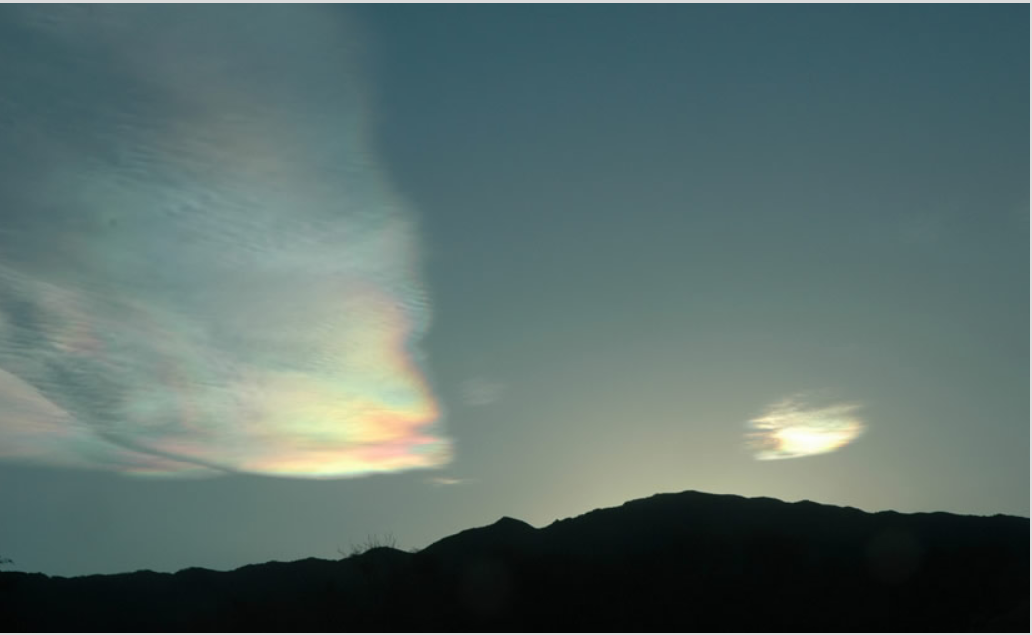Iridescent Clouds
Iridescent Clouds: Nature's Colorful Spectacle
Have you ever looked up at the sky and noticed vibrant, shimmering colors dancing within the clouds? These mesmerizing displays are known as iridescent clouds. They occur when certain conditions align, creating a stunning optical phenomenon that delights observers around the world. In this article, we will delve into the captivating world of iridescent clouds and explore their formation, characteristics, and where they are most commonly observed.
Unveiling the Science behind Iridescence
Iridescence in clouds occurs when thin cloud parts contain droplets of similar size. These droplets cause diffraction, resulting in the clouds shimmering with colors reminiscent of a corona. In essence, the colors we see are fragments of a corona. The term "iridescence" or "irisation" is derived from Iris, the Greek personification of the rainbow, capturing the enchanting and colorful nature of this phenomenon.
A Playful Dance of Colors
The delicate colors of iridescent clouds often manifest as random patches or bands at the edges of clouds. However, when droplet size is uniform throughout the cloud, they can form organized coronal rings. As clouds evolve and change shape, these bands and colors may also shift or disappear altogether. Altocumulus, cirrocumulus, and lenticular clouds are particularly prone to exhibiting iridescence. It is during cloud formation that iridescence is most prevalent, as all droplets share a similar history and size.
Chasing Iridescence: The Sun's Influence
While iridescence can occasionally be observed far from the sun, it is most commonly seen in close proximity to it. Similar to viewing coronas, safely observing iridescence involves hiding the sun behind a building or other objects. For an even better viewing experience, try observing the reflection of the sky in water, which can enhance the visibility of these ethereal colors.
Unveiling the Rare Gems: Nacreous Clouds
Among the rarer forms of iridescence are nacreous or mother-of-pearl clouds. These extraordinary clouds glow with exceptional brightness and are found at much higher altitudes than ordinary tropospheric clouds. Nacreous clouds create a truly awe-inspiring display, showcasing the full extent of nature's artistic prowess.
Iridescence Beyond the Clouds
Interestingly, iridescence is not limited to clouds alone. It can also be observed in rocket exhaust trails, adding a touch of color to the sky during space exploration endeavors. These striking displays serve as a reminder of how iridescence permeates various aspects of our atmosphere, transcending beyond the confines of the Earth's surface.
The Enigmatic Nature of Iridescence
Although we have gained some understanding of iridescence in clouds, this captivating phenomenon still holds many mysteries. Scientists continue to explore the intricate mechanisms behind its formation and the specific conditions required for its occurrence. The dynamic and ever-changing nature of iridescence ensures that each sighting is a unique and magical experience.
In conclusion, iridescent clouds offer us a glimpse into the enchanting beauty and complexity of our atmosphere. From the delicate colors that adorn cloud edges to the breathtaking displays of nacreous clouds, iridescence never fails to captivate our imagination. So, the next time you find yourself gazing at the sky, remember to look beyond the clouds and embrace the mesmerizing world of iridescence.

Iridescent clouds Salta Province, Western Argentina captured near sunset by Dallas Rhodes of Georgia USA. Iridescence in clouds most often occurs close to the sun. It is best seen when the sun is hidden. Here it behind the hill at right of centre. Image ©Dallas D. Rhodes, shown with permission.
When parts of clouds are thin and have similar size droplets, diffraction can make them shine with colours like a corona. In fact, the colours are essentially corona fragments. The effect is called cloud iridescence or irisation, terms derived from Iris the Greek personification of the rainbow.
The usually delicate colours can be in almost random patches or bands at cloud edges. They are only organised into coronal rings when the droplet size is uniform right across the cloud. The bands and colours change or come and go as the cloud evolves. They occur most often in altocumulus, cirrocumulus and especially in lenticular clouds. Iridescence is seen mostly when part of a cloud is forming because then all the droplets have a similar history and consequently have a similar size.
Sometimes iridescence can be seen far from the sun but is most frequent near to it. As for coronas, search safely by hiding the sun behind a building and, even better, also viewing the reflection of the sky in water.
Very much rarer iridescence is that of nacreous or mother-of-pearl clouds. They can glow very brightly and are far higher than ordinary tropospheric clouds. Iridescence is also seen in rocket exhaust trails.
Note: this article has been automatically converted from the old site and may not appear as intended. You can find the original article here.
Reference Atmospheric Optics
If you use any of the definitions, information, or data presented on Atmospheric Optics, please copy the link or reference below to properly credit us as the reference source. Thank you!
-
<a href="https://atoptics.co.uk/blog/iridescent-clouds/">Iridescent Clouds</a>
-
"Iridescent Clouds". Atmospheric Optics. Accessed on April 27, 2024. https://atoptics.co.uk/blog/iridescent-clouds/.
-
"Iridescent Clouds". Atmospheric Optics, https://atoptics.co.uk/blog/iridescent-clouds/. Accessed 27 April, 2024
-
Iridescent Clouds. Atmospheric Optics. Retrieved from https://atoptics.co.uk/blog/iridescent-clouds/.